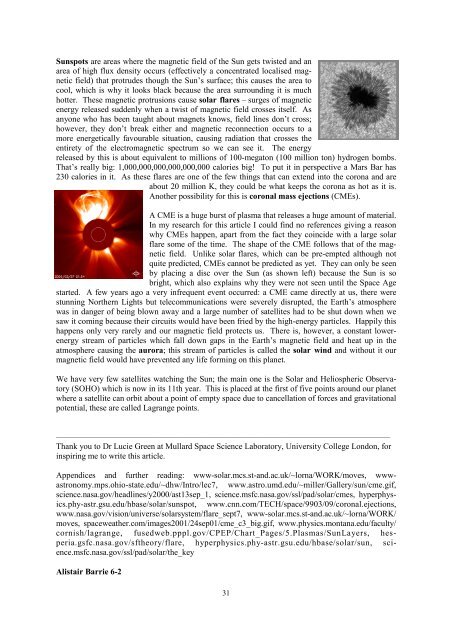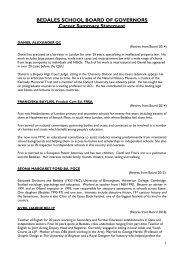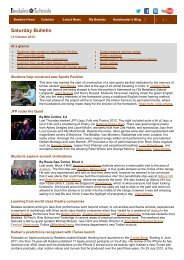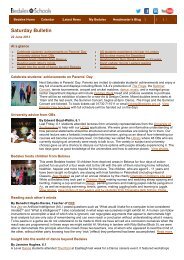You also want an ePaper? Increase the reach of your titles
YUMPU automatically turns print PDFs into web optimized ePapers that Google loves.
Sunspots are areas where the magnetic field of the Sun gets twisted and anarea of high flux density occurs (effectively a concentrated localised magneticfield) that protrudes though the Sun’s surface; this causes the area tocool, which is why it looks black because the area surrounding it is muchhotter. These magnetic protrusions cause solar flares – surges of magneticenergy released suddenly when a twist of magnetic field crosses itself. Asanyone who has been taught about magnets knows, field lines don’t cross;however, they don’t break either and magnetic reconnection occurs to amore energetically favourable situation, causing radiation that crosses theentirety of the electromagnetic spectrum so we can see it. The energyreleased by this is about equivalent to millions of 100-megaton (100 million ton) hydrogen bombs.That’s really big: 1,000,000,000,000,000,000 calories big! To put it in perspective a Mars Bar has230 calories in it. As these flares are one of the few things that can extend into the corona and areabout 20 million K, they could be what keeps the corona as hot as it is.Another possibility for this is coronal mass ejections (CMEs).A CME is a huge burst of plasma that releases a huge amount of material.In my research for this article I could find no references giving a reasonwhy CMEs happen, apart from the fact they coincide with a large solarflare some of the time. The shape of the CME follows that of the magneticfield. Unlike solar flares, which can be pre-empted although notquite predicted, CMEs cannot be predicted as yet. They can only be seenby placing a disc over the Sun (as shown left) because the Sun is sobright, which also explains why they were not seen until the Space Agestarted. A few years ago a very infrequent event occurred: a CME came directly at us, there werestunning Northern Lights but telecommunications were severely disrupted, the Earth’s atmospherewas in danger of being blown away and a large number of satellites had to be shut down when wesaw it coming because their circuits would have been fried by the high-energy particles. Happily thishappens only very rarely and our magnetic field protects us. There is, however, a constant lowerenergystream of particles which fall down gaps in the Earth’s magnetic field and heat up in theatmosphere causing the aurora; this stream of particles is called the solar wind and without it ourmagnetic field would have prevented any life forming on this planet.We have very few satellites watching the Sun; the main one is the Solar and Heliospheric Observatory(SOHO) which is now in its 11th year. This is placed at the first of five points around our planetwhere a satellite can orbit about a point of empty space due to cancellation of forces and gravitationalpotential, these are called Lagrange points.————————————————————————————————————————Thank you to Dr Lucie Green at Mullard Space Science Laboratory, University College London, forinspiring me to write this article.Appendices and further reading: www-solar.mcs.st-and.ac.uk/~lorna/WORK/moves, wwwastronomy.mps.ohio-state.edu/~dhw/Intro/lec7,www.astro.umd.edu/~miller/Gallery/sun/cme.gif,science.nasa.gov/headlines/y2000/ast13sep_1, science.msfc.nasa.gov/ssl/pad/solar/cmes, hyperphysics.phy-astr.gsu.edu/hbase/solar/sunspot,www.cnn.com/TECH/space/9903/09/coronal.ejections,www.nasa.gov/vision/universe/solarsystem/flare_sept7, www-solar.mcs.st-and.ac.uk/~lorna/WORK/moves, spaceweather.com/images2001/24sep01/cme_c3_big.gif, www.physics.montana.edu/faculty/cornish/lagrange, fusedweb.pppl.gov/CPEP/Chart_Pages/5.Plasmas/SunLayers, hesperia.gsfc.nasa.gov/sftheory/flare,hyperphysics.phy-astr.gsu.edu/hbase/solar/sun, science.msfc.nasa.gov/ssl/pad/solar/the_keyAlistair Barrie 6-231
















